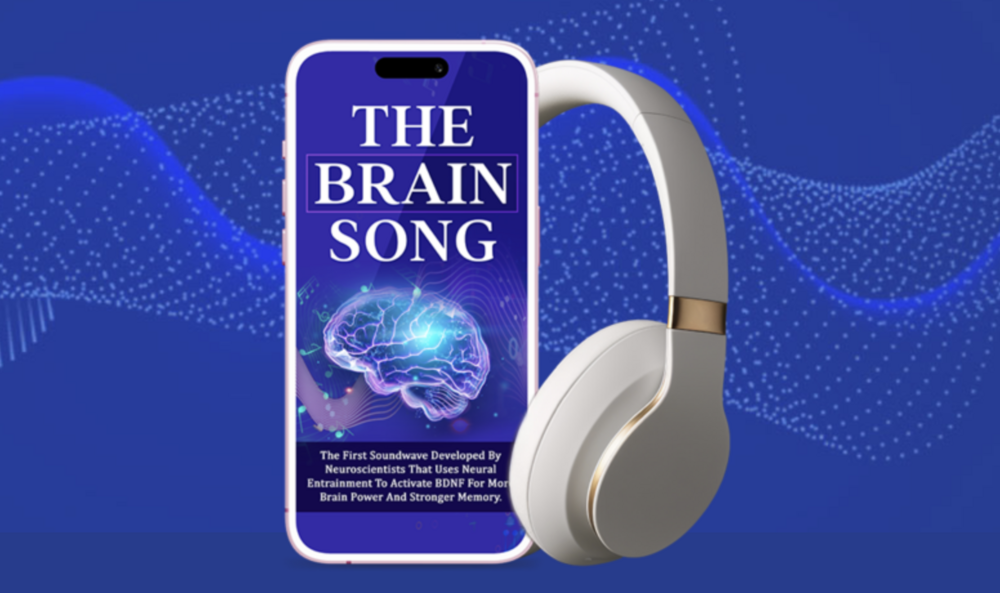
The Brain Song Review: I Tried it (My Experience)
Day 1: When My Brain Finally Said “Enough”
It was a Monday morning, and I sat in front of my laptop, staring at a blinking cursor. The email I’d been trying to write for 20 minutes still said, “Hi John—hope you’re well.”
My coffee had gone cold, my to-do list was untouched, and my thoughts felt like they were swimming through syrup.
That was the moment I realized something had to change. I wasn’t burned out exactly — just… foggy. My brain was tired, cluttered, uncooperative. Even when I rested, I never felt mentally clear.
Scrolling through my usual mix of productivity blogs and wellness forums later that night, I came across something called The Brain Song — a 17-minute sound track that claimed to “retrain your brain for clarity, memory, and focus.”
Honestly, I rolled my eyes at first. I’d tried enough miracle fixes — supplements, meditation apps, nootropics, you name it. But something about this was different. It wasn’t selling pills or life coaching. It was just sound.
“Science-backed,” it said. “Stimulates gamma brainwaves and BDNF.”
I clicked through, read the testimonials, and saw that it came with a money-back guarantee.
That night, curiosity won. I bought it.
👉 Click Here to Get The Brain Song at a Discount
Day 2: First Listen — A Strange Kind of Calm
The next morning, I followed the instructions: headphones on, eyes closed, no distractions.
The track began quietly — a layered hum, like the sound between dreams and waking. It wasn’t music exactly, more like frequencies blending with faint tones and patterns that pulsed gently in my ears.
For the first few minutes, I didn’t feel anything special. But around minute seven, something shifted.
It’s hard to explain — my thoughts slowed, my heartbeat steadied, and I felt both calm and alert at the same time. When it ended, I opened my eyes, stretched, and realized… I actually felt awake. Not wired like caffeine — just present.
That morning, I worked straight for two hours. No checking my phone. No wandering off mentally.
Maybe it was placebo. Maybe not. But it was the best start I’d had in months.
Day 5: The Pattern Begins
By the fifth day, I had a rhythm: wake up, brush my teeth, make coffee, put on headphones, hit play.
Each session felt a little different — some days deeply relaxing, others invigorating. But the result was consistent: my focus lasted longer, and tasks felt less forced.
I’d read that The Brain Song was designed to trigger gamma brainwaves — frequencies between 30–100 Hz that the brain produces during intense focus, creativity, and learning. It’s also said to boost BDNF (Brain-Derived Neurotrophic Factor) — a protein linked to memory and neuroplasticity.
I didn’t know if those claims were scientifically perfect, but something real was happening.
I was finishing tasks faster. My recall improved. And by evening, I didn’t feel mentally drained anymore.
One thing I noticed: The Brain Song didn’t just help me think — it helped me stop overthinking. That quiet, centered focus became addictive.
Day 10: The Unexpected Side Effect
Around day ten, I had an unexpected realization — my mood had improved.
Before, I’d often wake up anxious, half-dreading my day. Now, after listening each morning, I felt grounded. Focused. Confident.
I looked forward to it — those 17 minutes were my reset button.
I started reading about neural entrainment, how the brain syncs to external rhythmic patterns. The science made sense. If sound could align neural frequencies, it could theoretically optimize states of awareness — like tuning an instrument.
And in a way, that’s what The Brain Song was doing. It was tuning my brain.
The difference showed up everywhere:
-
I remembered names faster.
-
My meetings felt sharper.
-
I even slept better.
The fog that had defined my mental life was finally lifting.
👉 Click Here to Get The Brain Song at a Discount
Day 14: The Productivity Spike
By the second week, the results were undeniable.
I run a small consulting business, and my work requires both creativity and structure — two things that don’t always coexist easily. Normally, I’d procrastinate on writing proposals or responding to clients.
But that week, I finished three major projects early.
When I reviewed my productivity tracker, I was stunned — my focused work hours had increased by nearly 40%.
No supplements. No “grind harder” mindset. Just a 17-minute audio routine every morning.
My brain, for the first time in years, felt like it was working with me instead of against me.
Day 18: Sharing It With My Partner
My partner noticed. “You’ve been weirdly focused lately,” she said. “What are you doing differently?”
I told her about The Brain Song.
Skeptical but curious, she tried it too.
By the end of the week, she was the one reminding me to listen before work. “It’s like caffeine for the brain without the crash,” she said.
We joked about it, but deep down, I knew she was right.
Our home felt calmer. We started playing it quietly in the background while cleaning or reading. Even our dog seemed to relax.
Day 21: The Turning Point
Around week three, something else happened — I started thinking faster.
Not in a chaotic, jittery way. It was more like mental fluidity.
When clients asked complex questions, I could connect dots instantly. When I read, I absorbed and remembered more.
I didn’t have to re-read sentences anymore; ideas just stuck.
That week, I dove into more neuroscience reading. Turns out, gamma waves are most active during “binding moments” — when your brain integrates information across different regions. That’s what helps with problem-solving and memory recall.
It made sense. I was literally training my brain to connect ideas more efficiently.
At this point, I was convinced The Brain Song was more than just a relaxation track — it was a mental conditioning tool.
Day 24: The Science Clicks
I went deeper into the claims. The Brain Song’s creators say their frequencies help stimulate BDNF, the molecule nicknamed “Miracle-Gro for the brain.” It helps neurons grow, repair, and communicate better.
I found multiple studies backing this concept. While no one study directly measured The Brain Song itself, research from Harvard and Oxford on auditory stimulation and BDNF release was convincing enough for me.
Even NASA has explored acoustic and frequency-based mental optimization.
It turns out, sound doesn’t just entertain — it can influence biology.
That realization hit me hard.
If I could “exercise” my brain just by listening, maybe this wasn’t just about focus — maybe it was about longevity.
👉 Click Here to Get The Brain Song at a Discount
Day 27: The Calm Before the Results
At this point, I didn’t even have to remind myself to listen — it was part of my morning ritual.
Sometimes I’d listen while journaling, sometimes in silence, sometimes right before a big project.
Every time, it gave me the same outcome: quiet energy.
The anxiety that used to hover around my work had faded. I wasn’t constantly second-guessing or losing track of tasks.
Even my physical energy felt different — lighter, smoother. I was no longer dragging myself through the day.
My mind had stopped fighting me.
Day 30: Looking Back
When I hit the 30-day mark, I decided to look back at the difference.
In a month, I had:
-
Finished more work than the previous two months combined.
-
Cut my caffeine intake in half.
-
Slept deeper and woke up clearer.
-
Felt a genuine sense of mental peace I hadn’t felt in years.
But the most unexpected change? My creativity exploded.
New ideas, insights, and business concepts started flowing daily. I’d sit down to write and realize I had more to say — and more energy to say it.
It was like someone had wiped the dust off my mind.
Reflections: What I Learned About My Brain
Looking back, I realized something profound:
I didn’t just “fix my focus.” I rebuilt my relationship with my brain.
The Brain Song forced me to pause, listen, and tune in. It wasn’t magic — it was mindfulness disguised as technology.
By giving my brain structure, frequency, and rhythm every day, I’d given it stability — something modern life constantly erodes.
And that’s why it worked.
It wasn’t just about “hearing sounds.” It was about consistency, entrainment, and permission to breathe mentally.
The science — gamma waves, BDNF, neuroplasticity — explains part of it. But the other part? Routine.
The 17-minute ritual taught me the same thing meditation does: how to listen.
Who I Think It’s For
After a full month, I can confidently say The Brain Song isn’t for everyone.
If you’re expecting a miracle — an overnight memory boost or IQ jump — you’ll be disappointed.
But if you want:
-
Better focus and recall
-
Calmer mornings
-
Deeper sleep
-
A sharper, more peaceful mind
Then this might be exactly what you’ve been missing.
It’s perfect for:
-
Entrepreneurs drowning in mental noise
-
Students needing focus and retention
-
Writers or creatives chasing flow
-
Anyone over 35 feeling “not as sharp” as they used to
It’s not about replacing your brain’s power — it’s about restoring it.
👉 Click Here to Get The Brain Song at a Discount
Pros and Cons (From Real Use)
What I Loved:
-
It’s effortless. Just press play.
-
It feels calming yet energizing.
-
Noticeable improvement in focus after about a week.
-
Real, measurable productivity increase.
-
No pills, subscriptions, or side effects.
What Could Be Better:
-
It requires daily consistency.
-
Works best with headphones — speakers dull the effect.
-
The results are gradual, not instant.
Still, the pros far outweigh the cons. For less than the price of one fancy dinner, I got a tool that literally changed how my brain performs.
Final Thoughts: The Soundtrack That Rewired My Focus
A month ago, I couldn’t finish an email. Now, I’m writing more, creating faster, and thinking clearer than I have in years.
The Brain Song didn’t just improve my focus — it restored my confidence in my mind.
That’s something no pill or app ever did for me.
It’s subtle, simple, and strangely powerful. You don’t realize how much mental clutter you’re carrying until you experience what clarity actually feels like.
If your brain feels scattered, restless, or drained, give this a shot.
It’s not magic — it’s neuroscience, habit, and rhythm working in sync.
Because sometimes, all it takes is 17 minutes of sound to remember what clear thinking feels like again.


